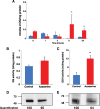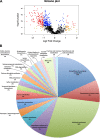Quantitative Proteomics Shows Extensive Remodeling Induced by Nitrogen Limitation in Prochlorococcusmarinus SS120
- PMID: 28593196
- PMCID: PMC5451487
- DOI: 10.1128/mSystems.00008-17
Quantitative Proteomics Shows Extensive Remodeling Induced by Nitrogen Limitation in Prochlorococcusmarinus SS120
Abstract
Prochlorococcus requires the capability to accommodate to environmental changes in order to proliferate in oligotrophic oceans, in particular regarding nitrogen availability. A precise knowledge of the composition and changes in the proteome can yield fundamental insights into such a response. Here we report a detailed proteome analysis of the important model cyanobacterium Prochlorococcus marinus SS120 after treatment with azaserine, an inhibitor of ferredoxin-dependent glutamate synthase (GOGAT), to simulate extreme nitrogen starvation. In total, 1,072 proteins, corresponding to 57% of the theoretical proteome, were identified-the maximum proteome coverage obtained for any Prochlorococcus strain thus far. Spectral intensity, calibrated quantification by the Hi3 method, was obtained for 1,007 proteins. Statistically significant changes (P value of <0.05) were observed for 408 proteins, with the majority of proteins (92.4%) downregulated after 8 h of treatment. There was a strong decrease in ribosomal proteins upon azaserine addition, while many transporters were increased. The regulatory proteins PII and PipX were decreased, and the global nitrogen regulator NtcA was upregulated. Furthermore, our data for Prochlorococcus indicate that NtcA also participates in the regulation of photosynthesis. Prochlorococcus responds to the lack of nitrogen by slowing down translation, while inducing photosynthetic cyclic electron flow and biosynthesis of proteins involved in nitrogen uptake and assimilation. IMPORTANCEProchlorococcus is the most abundant photosynthetic organism on Earth, contributing significantly to global primary production and playing a prominent role in biogeochemical cycles. Here we study the effects of extreme nitrogen limitation, a feature of the oligotrophic oceans inhabited by this organism. Quantitative proteomics allowed an accurate quantification of the Prochlorococcus proteome, finding three main responses to nitrogen limitation: upregulation of nitrogen assimilation-related proteins, including transporters; downregulation of ribosome proteins; and induction of the photosystem II cyclic electron flow. This suggests that nitrogen limitation affects a range of metabolic processes far wider than initially believed, with the ultimate goal of saving nitrogen and maximizing the nitrogen uptake and assimilation capabilities of the cell.
Keywords: marine cyanobacteria; nitrogen limitation; nitrogen metabolism; prochlorococcus; quantitative proteomics.
Figures





Similar articles
-
Nitrogen starvation induces extensive changes in the redox proteome of Prochlorococcus sp. strain SS120.Environ Microbiol Rep. 2012 Apr;4(2):257-67. doi: 10.1111/j.1758-2229.2012.00329.x. Epub 2012 Feb 20. Environ Microbiol Rep. 2012. PMID: 23757281
-
Expression of genes involved in nitrogen assimilation and the C/N balance sensing in Prochlorococcus sp. strain SS120.Gene Expr. 2009;14(5):279-89. doi: 10.3727/105221609788681204. Gene Expr. 2009. PMID: 19630271 Free PMC article.
-
Differential NtcA Responsiveness to 2-Oxoglutarate Underlies the Diversity of C/N Balance Regulation in Prochlorococcus.Front Microbiol. 2018 Jan 9;8:2641. doi: 10.3389/fmicb.2017.02641. eCollection 2017. Front Microbiol. 2018. PMID: 29375510 Free PMC article.
-
Adaptive mechanisms of nitrogen and carbon assimilatory pathways in the marine cyanobacteria Prochlorococcus.Res Microbiol. 2004 Dec;155(10):795-802. doi: 10.1016/j.resmic.2004.06.009. Res Microbiol. 2004. PMID: 15567272 Review.
-
The PII-NAGK-PipX-NtcA Regulatory Axis of Cyanobacteria: A Tale of Changing Partners, Allosteric Effectors and Non-covalent Interactions.Front Mol Biosci. 2018 Nov 13;5:91. doi: 10.3389/fmolb.2018.00091. eCollection 2018. Front Mol Biosci. 2018. PMID: 30483512 Free PMC article. Review.
Cited by
-
Basin-scale biogeography of marine phytoplankton reflects cellular-scale optimization of metabolism and physiology.Sci Adv. 2022 Jan 21;8(3):eabl4930. doi: 10.1126/sciadv.abl4930. Epub 2022 Jan 21. Sci Adv. 2022. PMID: 35061539 Free PMC article.
-
Membrane organization of photosystem I complexes in the most abundant phototroph on Earth.Nat Plants. 2019 Aug;5(8):879-889. doi: 10.1038/s41477-019-0475-z. Epub 2019 Jul 22. Nat Plants. 2019. PMID: 31332310 Free PMC article.
-
Pipeline for Targeted Meta-Proteomic Analyses to Assess the Diversity of Cattle Rumen Microbial Urease.Front Microbiol. 2020 Sep 18;11:573414. doi: 10.3389/fmicb.2020.573414. eCollection 2020. Front Microbiol. 2020. PMID: 33072036 Free PMC article.
-
Quantitative Proteomic and Microcystin Production Response of Microcystis aeruginosa to Phosphorus Depletion.Microorganisms. 2021 May 31;9(6):1183. doi: 10.3390/microorganisms9061183. Microorganisms. 2021. PMID: 34072711 Free PMC article.
-
Current Status and Future Strategies to Increase Secondary Metabolite Production from Cyanobacteria.Microorganisms. 2020 Nov 24;8(12):1849. doi: 10.3390/microorganisms8121849. Microorganisms. 2020. PMID: 33255283 Free PMC article. Review.
References
-
- Chisholm SW, Frankel SL, Goericke R, Olson RJ, Palenik B, Waterbury JB, West-Johnsrud L, Zettler ER. 1992. Prochlorococcus marinus nov. gen. nov. sp.: an oxyphototrophic marine prokaryote containing divinyl chlorophyll a and chlorophyll b. Arch Microbiol 157:297–300. doi: 10.1007/BF00245165. - DOI
-
- Chisholm SW, Olson RJ, Zettler ER, Goericke R, Waterbury JB, Welschmeyer NA. 1988. A novel free-living prochlorophyte abundant in the oceanic euphotic zone. Nature 334:340–343. doi: 10.1038/334340a0. - DOI
-
- Liu H, Nolla H, Campbell L. 1997. Prochlorococcus growth rate and contribution to primary production in the equatorial and subtropical North Pacific Ocean. Aquat Microb Ecol 12:39–47. doi: 10.3354/ame012039. - DOI
-
- Kettler GC, Martiny AC, Huang K, Zucker J, Coleman ML, Rodrigue S, Chen F, Lapidus A, Ferriera S, Johnson J, Steglich C, Church GM, Richardson P, Chisholm SW. 2007. Patterns and implications of gene gain and loss in the evolution of Prochlorococcus. PLoS Genet 3:e231. doi: 10.1371/journal.pgen.0030231. - DOI - PMC - PubMed
LinkOut - more resources
Full Text Sources
Other Literature Sources

